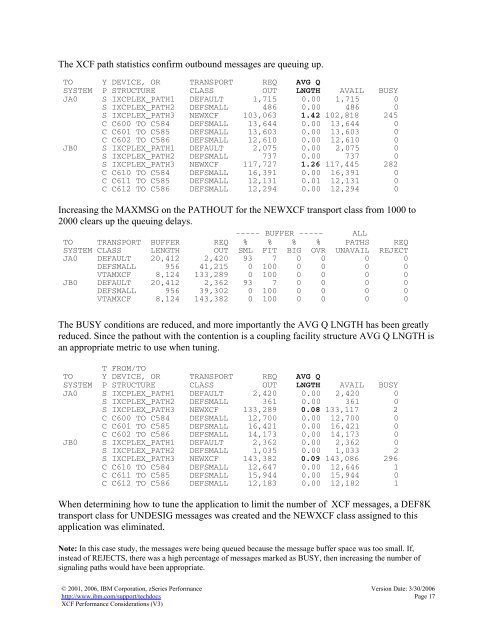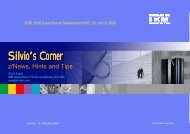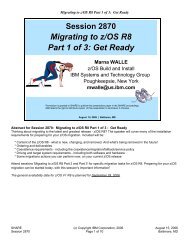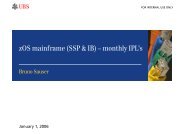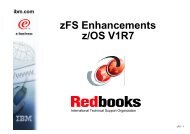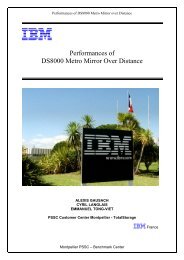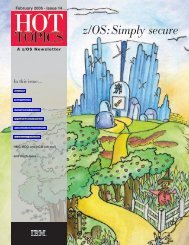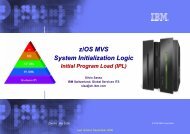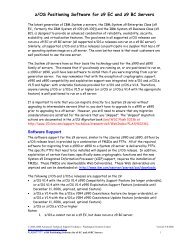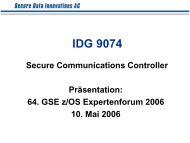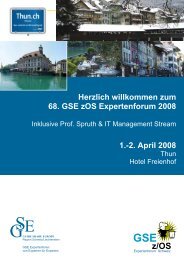Xcf Performance Considerations - Messmer The Brain House
Xcf Performance Considerations - Messmer The Brain House
Xcf Performance Considerations - Messmer The Brain House
Create successful ePaper yourself
Turn your PDF publications into a flip-book with our unique Google optimized e-Paper software.
<strong>The</strong> XCF path statistics confirm outbound messages are queuing up.<br />
TO Y DEVICE, OR TRANSPORT REQ AVG Q<br />
SYSTEM P STRUCTURE CLASS OUT LNGTH AVAIL BUSY<br />
JA0 S IXCPLEX_PATH1 DEFAULT 1,715 0.00 1,715 0<br />
S IXCPLEX_PATH2 DEFSMALL 486 0.00 486 0<br />
S IXCPLEX_PATH3 NEWXCF 103,063 1.42 102,818 245<br />
C C600 TO C584 DEFSMALL 13,644 0.00 13,644 0<br />
C C601 TO C585 DEFSMALL 13,603 0.00 13,603 0<br />
C C602 TO C586 DEFSMALL 12,610 0.00 12,610 0<br />
JB0 S IXCPLEX_PATH1 DEFAULT 2,075 0.00 2,075 0<br />
S IXCPLEX_PATH2 DEFSMALL 737 0.00 737 0<br />
S IXCPLEX_PATH3 NEWXCF 117,727 1.26 117,445 282<br />
C C610 TO C584 DEFSMALL 16,391 0.00 16,391 0<br />
C C611 TO C585 DEFSMALL 12,131 0.01 12,131 0<br />
C C612 TO C586 DEFSMALL 12,294 0.00 12,294 0<br />
Increasing the MAXMSG on the PATHOUT for the NEWXCF transport class from 1000 to<br />
2000 clears up the queuing delays.<br />
----- BUFFER ----- ALL<br />
TO TRANSPORT BUFFER REQ % % % % PATHS REQ<br />
SYSTEM CLASS LENGTH OUT SML FIT BIG OVR UNAVAIL REJECT<br />
JA0 DEFAULT 20,412 2,420 93 7 0 0 0 0<br />
DEFSMALL 956 41,215 0 100 0 0 0 0<br />
VTAMXCF 8,124 133,289 0 100 0 0 0 0<br />
JB0 DEFAULT 20,412 2,362 93 7 0 0 0 0<br />
DEFSMALL 956 39,302 0 100 0 0 0 0<br />
VTAMXCF 8,124 143,382 0 100 0 0 0 0<br />
<strong>The</strong> BUSY conditions are reduced, and more importantly the AVG Q LNGTH has been greatly<br />
reduced. Since the pathout with the contention is a coupling facility structure AVG Q LNGTH is<br />
an appropriate metric to use when tuning.<br />
T FROM/TO<br />
TO Y DEVICE, OR TRANSPORT REQ AVG Q<br />
SYSTEM P STRUCTURE CLASS OUT LNGTH AVAIL BUSY<br />
JA0 S IXCPLEX_PATH1 DEFAULT 2,420 0.00 2,420 0<br />
S IXCPLEX_PATH2 DEFSMALL 361 0.00 361 0<br />
S IXCPLEX_PATH3 NEWXCF 133,289 0.08 133,117 2<br />
C C600 TO C584 DEFSMALL 12,700 0.00 12,700 0<br />
C C601 TO C585 DEFSMALL 16,421 0.00 16,421 0<br />
C C602 TO C586 DEFSMALL 14,173 0.00 14,173 0<br />
JB0 S IXCPLEX_PATH1 DEFAULT 2,362 0.00 2,362 0<br />
S IXCPLEX_PATH2 DEFSMALL 1,035 0.00 1,033 2<br />
S IXCPLEX_PATH3 NEWXCF 143,382 0.09 143,086 296<br />
C C610 TO C584 DEFSMALL 12,647 0.00 12,646 1<br />
C C611 TO C585 DEFSMALL 15,944 0.00 15,944 0<br />
C C612 TO C586 DEFSMALL 12,183 0.00 12,182 1<br />
When determining how to tune the application to limit the number of XCF messages, a DEF8K<br />
transport class for UNDESIG messages was created and the NEWXCF class assigned to this<br />
application was eliminated.<br />
Note: In this case study, the messages were being queued because the message buffer space was too small. If,<br />
instead of REJECTS, there was a high percentage of messages marked as BUSY, then increasing the number of<br />
signaling paths would have been appropriate.<br />
© 2001, 2006, IBM Corporation, zSeries <strong>Performance</strong> Version Date: 3/30/2006<br />
http://www.ibm.com/support/techdocs Page 17<br />
XCF <strong>Performance</strong> <strong>Considerations</strong> (V3)


